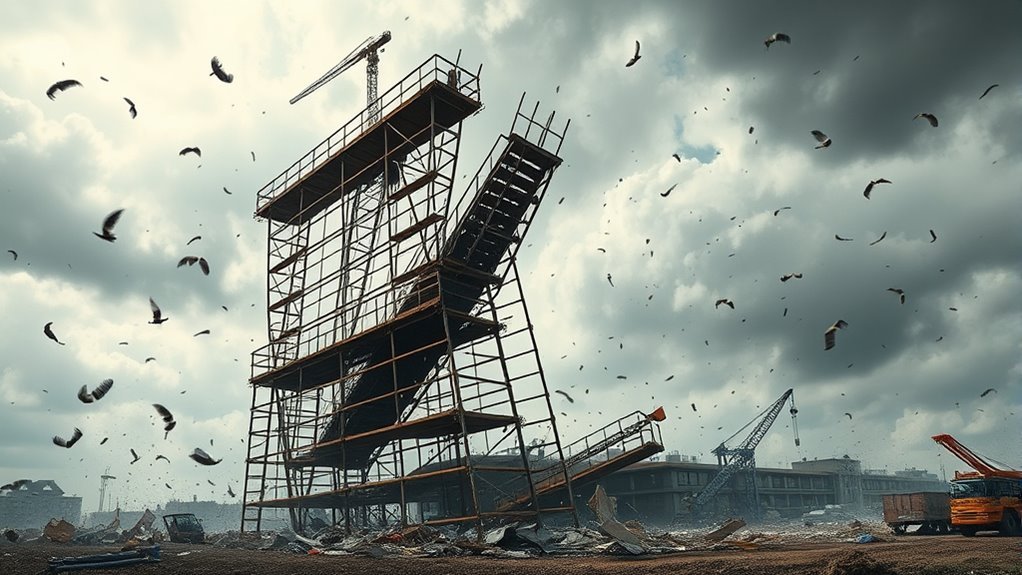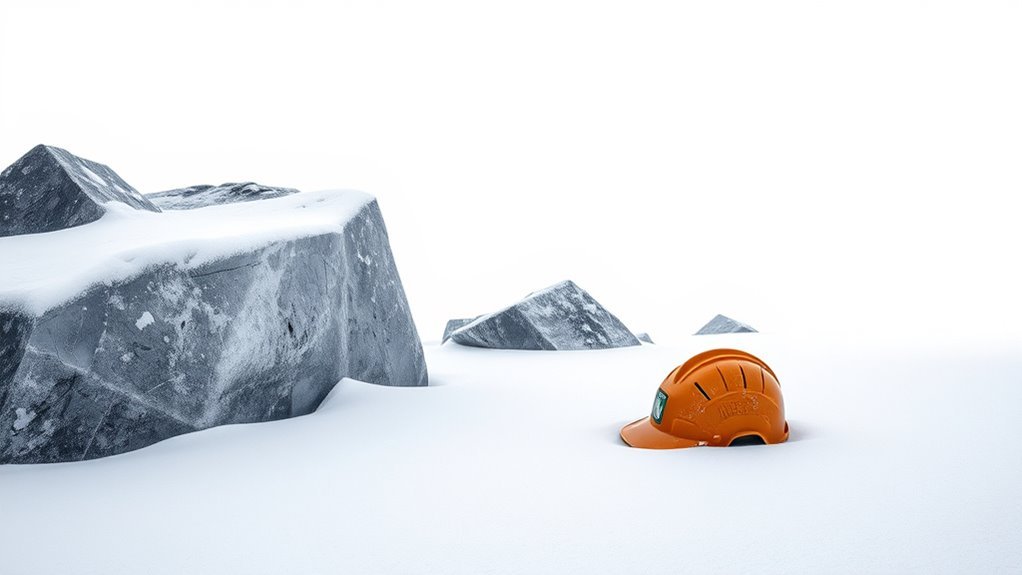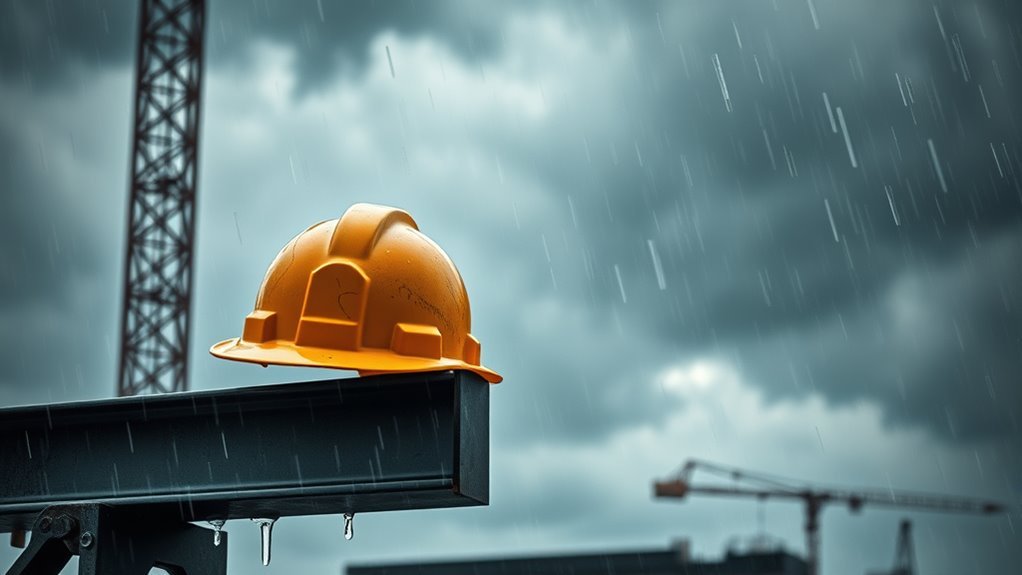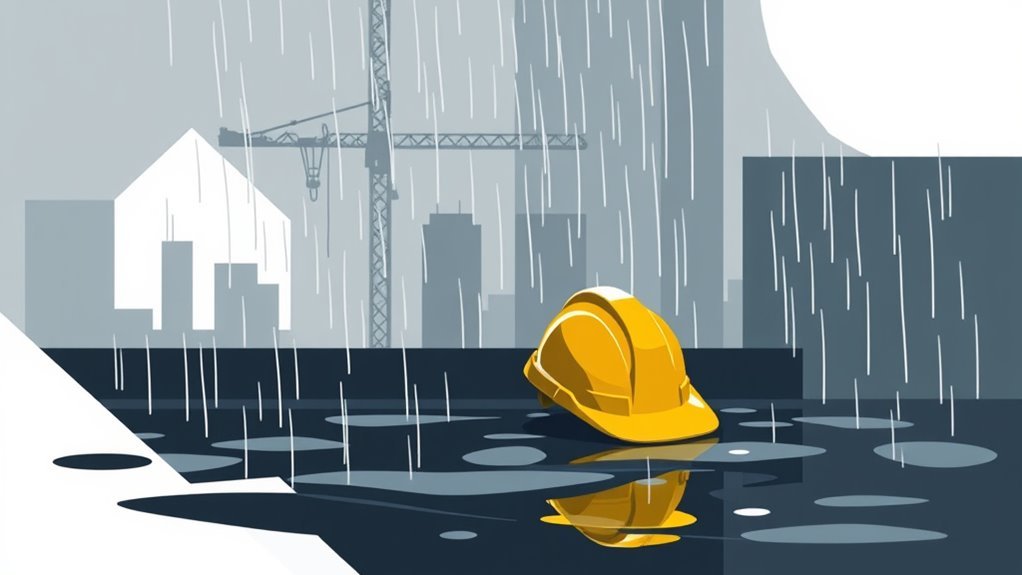Squall weather presents considerable dangers to outdoor construction jobs. Intense winds can send debris flying, posing injury risks, while heavy rain complicates visibility and increases the chance of slips and falls. Cold temperatures exacerbate these hazards, leading to risks of hypothermia and equipment malfunctions. Proper safety gear and training are essential for mitigating these dangers. Understanding how to prepare for and respond to squall conditions can improve general safety in the construction environment, revealing more crucial strategies for protection.
Main Points
- Sudden squalls can cause high winds and heavy rain, posing immediate safety risks to construction workers and disrupting project timelines.
- Flying debris during squalls can lead to serious injuries and damage to equipment, necessitating proper safety gear to mitigate risks.
- High winds can destabilize scaffolding and machinery, increasing the likelihood of falls or accidents on construction sites.
- Reduced visibility from heavy rain and dust complicates navigation, heightening the risk of slips, trips, and falls.
- Cold temperatures accompanying squalls can lead to hypothermia and decreased dexterity, affecting workers' ability to handle tools safely.
Understanding Squall Weather and Its Impact on Outdoor Jobs
Although squall weather can occur suddenly and with little warning, understanding its characteristics is fundamental for those engaged in outdoor construction work. Squalls are defined as brief, intense storms that often bring strong winds, heavy rain, and sometimes hail or snow. These weather phenomena can develop rapidly, disrupting project timelines and posing risks to worker safety.
The sudden onset of high winds can create dangerous conditions, making it difficult for workers to maintain control of equipment and materials. Additionally, the accompanying precipitation can reduce visibility, complicating tasks and increasing the likelihood of accidents.
Awareness of squall weather patterns and forecasts can equip construction teams to prepare adequately. Adequate planning, such as securing materials and implementing safety protocols, is essential in mitigating risks associated with these unpredictable storms.
In general, recognizing the potential impact of squall weather is important for ensuring a safer working environment in outdoor construction settings.
Common Hazards Associated With High Winds

High winds present a range of hazards that can considerably impact construction work and worker safety. When gusts reach notable speeds, the risks increase dramatically, posing threats to both personnel and equipment on-site. Awareness of these hazards is essential for mitigating potential accidents.
- Flying debris: Loose materials can become projectiles, injuring workers or damaging equipment.
- Unstable scaffolding: High winds can destabilize scaffolding, risking falls or collapses.
- Equipment topple: Heavy machinery may be at risk of overturning if not secured properly.
- Reduced visibility: Dust and debris stirred up by the wind can obstruct visibility, making it difficult to maneuver the site safely.
- Increased fatigue: Workers may struggle against the wind, leading to exhaustion and decreased focus.
Employers should implement safety protocols and training to address these high-wind challenges effectively.
The Risks of Heavy Rain and Flooding on Construction Sites
Heavy rain and flooding can considerably increase slip hazards on construction sites, posing serious risks to workers' safety.
Additionally, the accumulation of water can lead to damage of equipment, which may result in costly delays and repairs.
Understanding these risks is essential for maintaining a safe and efficient work environment during adverse weather conditions.
Increased Slip Hazards
When construction sites are subjected to intense rainfall and flooding, the risk of slip hazards markedly increases, posing a serious threat to worker safety.
Wet surfaces can become treacherous, leading to falls that may result in severe injuries. Workers are particularly vulnerable during these conditions, as they traverse uneven terrains and exposed materials.
The following factors contribute to the heightened risk of slips:
- Mud accumulation on walkways and working areas
- Puddles that obscure underlying hazards
- Slippery tools and equipment left in the rain
- Debris washed onto pathways, creating obstacles
- Reduced visibility, making it difficult to assess risks
These elements underscore the importance of vigilance and appropriate precautions during adverse weather conditions.
Equipment Damage Risks
Intense rainfall and flooding can wreak havoc on construction equipment, leading to costly damages and operational delays. Heavy rain can cause water accumulation on sites, which may submerge machinery, leading to engine failures and electrical malfunctions.
Additionally, flooding can displace tools and materials, resulting in loss or damage. Operators may struggle to maneuver flooded areas, increasing the risk of accidents that can further damage equipment.
Rust and corrosion may develop on exposed machinery due to prolonged moisture exposure, greatly reducing the lifespan of the equipment. Moreover, wet conditions can complicate the maintenance of hydraulic systems and other sensitive components, necessitating expensive repairs.
As a result, understanding and mitigating these risks is essential for maintaining operational efficiency and minimizing financial losses on construction sites.
Temperature Drops: How Cold Weather Affects Worker Safety

As temperatures plummet, construction workers face heightened risks that can compromise their safety and efficiency on the job site. Cold weather can lead to serious health concerns, including hypothermia and frostbite, while also impairing physical performance and mental acuity.
The chilling conditions can exacerbate the likelihood of accidents, making it essential for workers and supervisors to remain vigilant.
- Reduced dexterity due to numb fingers, affecting tool handling
- Increased fatigue from battling the cold, diminishing focus
- Slippery surfaces from ice or snow, raising fall risks
- Delayed reaction times in emergency situations
- Potential for equipment malfunction in frigid temperatures
Understanding these dangers is vital for maintaining a safe working environment.
Proper planning and awareness can help mitigate the negative impacts of dropping temperatures on construction activities.
The Importance of Proper Safety Gear and Equipment

Safety is essential on construction sites, particularly during adverse weather conditions such as squalls. Proper safety gear and equipment play a critical role in protecting workers from various hazards associated with unpredictable weather.
During squalls, workers face heightened risks, including slips, falls, and exposure to harsh elements. Wearing appropriate clothing, such as waterproof jackets and insulated layers, helps maintain body temperature and reduces the risk of hypothermia. Safety helmets equipped with visors protect against flying debris, while non-slip footwear guarantees stability on wet surfaces.
Additionally, high-visibility vests are vital for increasing worker visibility in low-light conditions often accompanying squalls. Employers must prioritize equipping their teams with the right safety gear to mitigate risks effectively.
Investing in quality equipment not only improves worker safety but also cultivates a culture of responsibility and awareness on construction sites. In the end, proper safety gear is indispensable in safeguarding workers during challenging weather conditions.
Implementing Safety Protocols During Adverse Weather Conditions
Effective implementation of safety protocols during adverse weather conditions is essential for protecting construction workers.
Utilizing advanced weather monitoring systems can provide timely updates on changing conditions, allowing for informed decision-making.
Additionally, thorough employee training programs guarantee that workers are prepared to respond appropriately to severe weather threats.
Weather Monitoring Systems
A robust weather monitoring system is essential for mitigating risks associated with construction work during squall conditions.
These systems provide real-time data and forecasts, allowing site managers to make informed decisions quickly. Implementing such systems improves safety protocols and reduces the likelihood of accidents.
- Continuous monitoring of temperature, humidity, and wind speed
- Alerts for sudden changes in weather patterns
- Integration with mobile gadgets for instant notifications
- Historical data analysis for predicting potential squall events
- Coordination with local meteorological services for accurate forecasts
Employee Training Programs
Although adverse weather conditions can pose considerable risks on construction sites, thorough employee training programs play an essential role in implementing effective safety protocols. Such programs equip workers with the knowledge and skills necessary to identify hazardous weather conditions and respond appropriately.
Training sessions should cover the use of personal protective equipment, emergency evacuation procedures, and communication strategies during squalls. Regular drills and simulations reinforce these concepts, ensuring employees are prepared for real-life situations.
Additionally, ongoing education on the latest safety regulations and techniques promotes a culture of safety and awareness. By prioritizing employee training, construction companies can considerably mitigate risks associated with squall weather, ultimately enhancing worker safety and project efficiency.
Training and Preparedness: Keeping Workers Safe in Squall Weather
To guarantee the safety of construction workers during squall weather, proper training and preparedness are essential. Employers must equip their crews with knowledge and skills to identify and respond to changing weather conditions effectively. This proactive approach minimizes risks and improves worker safety.
Key components of training and preparedness include:
- Weather Forecast Monitoring: Regularly check forecasts to anticipate squall conditions.
- Emergency Protocols: Establish clear procedures for evacuation and sheltering during severe weather.
- Safety Equipment: Confirm that workers have access to appropriate gear, such as raincoats and non-slip footwear.
- Communication Plans: Implement reliable systems for notifying workers of weather changes in real-time.
- Mock Drills: Conduct regular drills to familiarize workers with emergency procedures and reinforce their importance.
Common Questions
How Can Squall Weather Affect Project Timelines and Deadlines?
Squall weather can greatly disrupt project timelines and deadlines. Inclement conditions often lead to halted work, delayed deliveries, and increased safety concerns, eventually resulting in extended timeframes and potential financial repercussions for project stakeholders.
What Measures Can Workers Take to Stay Dry During Heavy Rain?
Workers can stay dry during heavy rain by using waterproof clothing, such as rain jackets and pants, employing tarps for cover, and utilizing appropriate gear like waterproof boots and hats to minimize exposure to moisture.
Are There Specific Regulations for Working in Squall Conditions?
The regulations for working in squall conditions typically emphasize safety protocols, requiring employers to assess risks, provide protective gear, and guarantee workers are trained to respond to sudden weather changes effectively, prioritizing their safety and well-being.
How Do Squalls Impact Equipment Operation on Construction Sites?
Squalls greatly impact equipment operation on construction sites by causing visibility issues, reducing traction, and increasing the risk of equipment malfunction. Operators must exercise caution, often leading to delays and potential hazards during adverse weather conditions.
What Should Workers Do if Caught Outside During a Squall?
When caught outside during a squall, workers should seek immediate shelter, avoid large structures and trees, crouch low if necessary, and remain vigilant for changing weather conditions to guarantee their safety until the squall passes.

